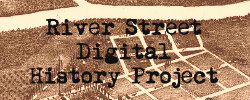 Home-Grown Archaeologist Researches His Roots
Home-Grown Archaeologist Researches His Roots
Archaeologist Bill White, III has returned to research the River Street Neighborhood in downtown Boise, which was the historical center of the city’s African American population. Using funding provided by the Boise City Department of Arts and History, White has returned to his hometown to collect archival documents and record interviews with former residents in an attempt to document this community before it is lost to redevelopment. His work focuses on digitizing the collected information so it can be shared with the community via a website: the River Street Digital History Project (http://www.riverstreethistory.com/).
“I wanted to come home and spread the word about the lives of black people in Boise,” said White. “Most of the country doesn’t know this, but we’ve been here since the city was founded.” Bill grew up in Boise and is very fond of his home. He graduated from Boise State University in 2001 and earned a Master’s from the University of Idaho in 2004. Since then, he has been working as a historical archaeology across the country. He has worked at a variety of archaeological sites including George Washington’s boyhood home in Fredericksburg, Virginia, a Japanese millworker’s village in Mukilteo, Washington, and a 10,000-year-old Native American site in Glacier National Park in Montana. This research on the River Street Neighborhood will be used towards the PhD he is currently working on at the University of Arizona in Tucson.
 The River Street Neighborhood was created in the 1890s and evolved into a working-class community that was sandwiched between warehouses near the 8th Street Marketplace and railroad tracks that used to occupy the eastbound lanes of the Broadway-Chinden Connector (Interstate 184). During the early twentieth century, River Street became known by its small population of African Americans but the neighborhood was primarily inhabited by individuals of other races including Chinese, Japanese, Basque, and European immigrants. It was a multi-racial community even though it was identified by its African American inhabitants. He has been interviewing long-time Boiseans and former neighborhood residents to collect information.
The River Street Neighborhood was created in the 1890s and evolved into a working-class community that was sandwiched between warehouses near the 8th Street Marketplace and railroad tracks that used to occupy the eastbound lanes of the Broadway-Chinden Connector (Interstate 184). During the early twentieth century, River Street became known by its small population of African Americans but the neighborhood was primarily inhabited by individuals of other races including Chinese, Japanese, Basque, and European immigrants. It was a multi-racial community even though it was identified by its African American inhabitants. He has been interviewing long-time Boiseans and former neighborhood residents to collect information.
White wants to focus on the multi-racial character of River Street. He said, “Most people know of River Street as ‘the Black Neighborhood’, but it was actually much more than that. It was the place where the others (non-white people) were forced to live because of the racial segregation that predominated in the past.” While acknowledging the important contributions African Americans in River Street made to Boise, White also wants to reveal the contributions of the other people that lived there.
In order to make these materials as accessible as possible, White created the River Street Digital History website where he has uploaded photographs, documents and created videos documenting the neighborhood’s history. This research was funded by grants from by the Boise City Department of Arts and History and the Redd Center for Western Studies at Brigham Young University. White plans on expanding upon this website by collecting more interviews with former residents and photographs from their personal collections.
This project is ongoing. You can contact Bill about this project at info@riverstreethistory.com or check out the website to learn more about the project: http://www.riverstreethistory.com/
Download a copy of this press release here: WAW_RiverStreetHistory_Press_Release
Contact Us if you have any questions or comments
